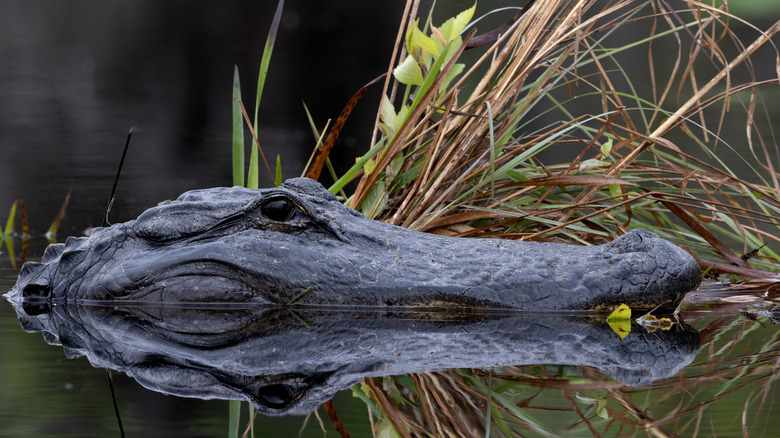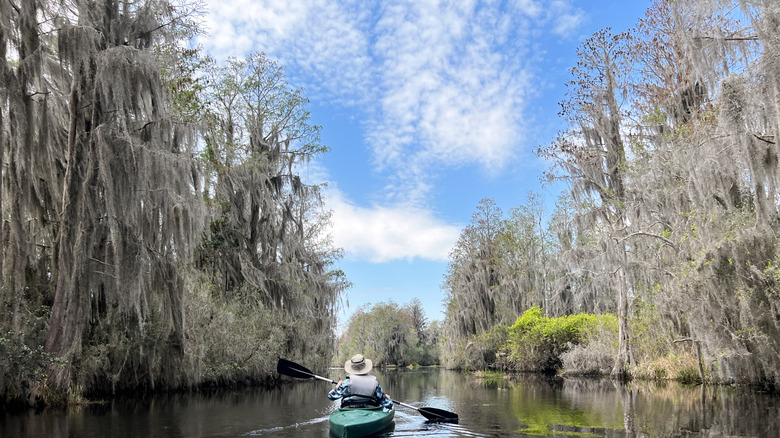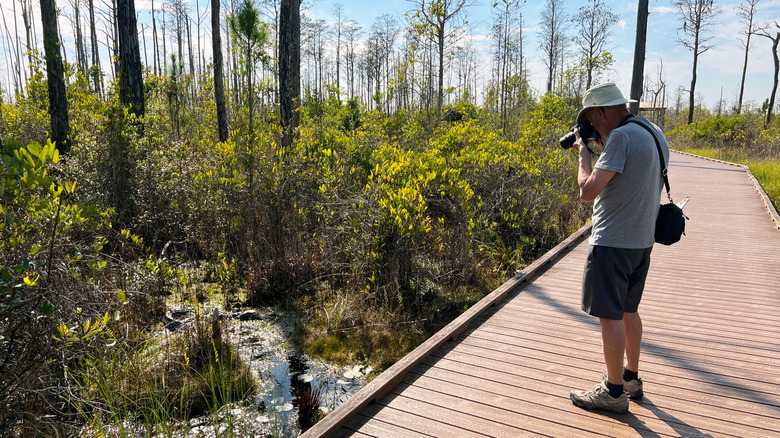Georgia's Serene National Wildlife Refuge Is A Must-Visit For Kayakers & Nature Lovers
If paddling through alligator-infested waters sounds fun, you should visit Okefenokee National Wildlife Reserve in Georgia, where there are more than 15,000 of the cold-blooded critters. As one of the largest and best-preserved freshwater wetland ecosystems in the U.S., the refuge is ideal for canoeing and kayaking, and has 680 square miles of wilderness to explore. Located 11.7 miles west of Folkston and 58.7 miles north of Jacksonville, it's one of the best places to see alligators in the wild, and home to a wealth of other wildlife.
Unlike many wetland areas, such as the Everglades, it's unique in being the source rather than the destination, and is the source of two major rivers. The Suwannee River, which runs south through Florida, where you'll find more national parks and refuges to add to your bucket list, and empties into the Gulf of Mexico (Gulf of America), and the St. Mary's River, which flows east, forming part of the Georgia-Florida border, before reaching the Atlantic Ocean. It's an important breeding ground for several endangered species, and is currently on the Tentative List for UNESCO World Heritage Status.
The refuge has three main entrances and two smaller ones, but first-time visitors should head to the east entrance, where the Richard S. Bolt Visitor Center is located. Open daily until 4PM, this is where you'll find maps, trail guides, and information on the best places to spot wildlife. The refuge itself is open from sunrise to sunset, and costs $4.50 for a day-pass.
Paddling trails in Okefenokee Swamp
With over 120 miles of designated canoe and kayak trails, Okefenokee is a paddler's paradise. You can make a day of it by following one of the eight color-coded trails or set off on multi-day trips, staying at campsites situated along the routes. The 16-mile Orange Trail is a moderate challenge that starts at the visitor center, cutting across the refuge and following the historic Suwanee Canal. It connects to other trails, and there are several shelters where you can stop for a picnic.
More experienced paddlers can tackle the Red Trail, a strenuous 30-mile route through the more remote north section of the refuge. It winds through Cyprus groves, prairies, and marshland, but you'll need to count on staying overnight, perhaps at Maul Hammock. Here, the clear night skies provide excellent stargazing. While most of the waterways will be quiet, being primarily for paddlers, some of the trails are open to day-use motorboats.
If you'd rather join guided boat trips or paddle tours at Okefenokee Adventures, experienced guides will share their insights on the unique wildlife and cultural history. The name 'Okefenokee' comes from the Creek language, believed to mean 'trembling earth'. Once home to the Timacua, the Creek later used the swamps as hunting grounds. If you're planning on spending time on the water, pack sun protection, as there's little shade, and don't forget the insect repellent. If you prefer staying on dry land, you can also rent a bike for the day for $20, or tackle the 7.5-mile Swamp Island Drive in the Suwanee Canal Recreation Area. Dotted along the drive are several trailheads where you can leave your vehicle behind and head out on the short, easy trails and explore further.
Best times for viewing wildlife in Okefenokee Wildlife Refuge
Established as a refuge and breeding ground, conservation has always been at the heart of Okefenokee. While the alligators are the most famous residents, wildlife enthusiasts and photographers will delight at seeing the rare gopher tortoises, red-cockaded woodpeckers, indigo snakes, and wood storks among the 39 fish, 37 amphibian, 64 reptile, 234 bird, and 50 mammal species found here. Insects are equally as diverse, with around 1000 species of moths. And the plantlife is impressive too, with pond cyprus trees over 500 years old, and over 620 species of plants providing the perfect scenery for your adventure, like other scenic landscapes in Georgia.
The best time to visit for wildlife viewing is early in the morning, when the dawn chorus fills the air, or at dusk, when the animals are out searching for food. Many birds are resident all year-round, but other migratory birds visit throughout the year. Up-to-date information on the best viewing spots can be found at the visitor center.
It's a good idea to leave your pets at home. Alligators are very protective of their young and can run surprisingly fast, if they feel threatened. Always keep your distance and don't ever attempt to feed them. Not only is it illegal, but it's extremely dangerous. To make the most of your experience, keep to the marked trails and boardwalks and take some binoculars to watch them from afar.


